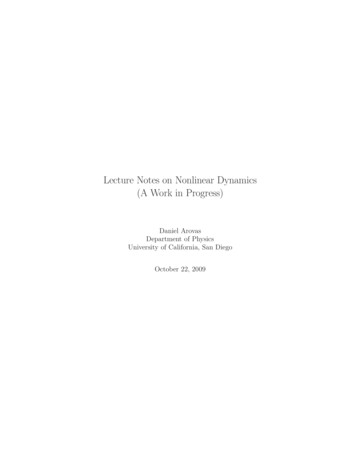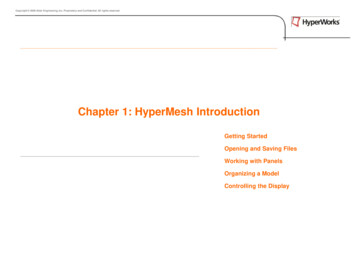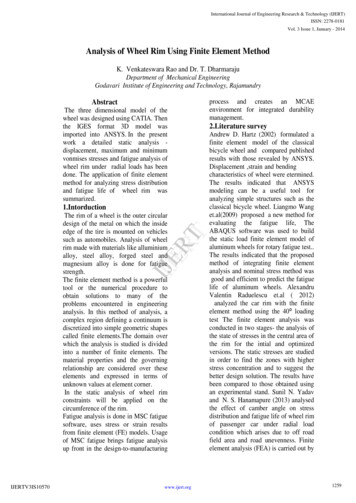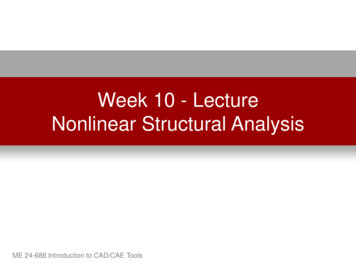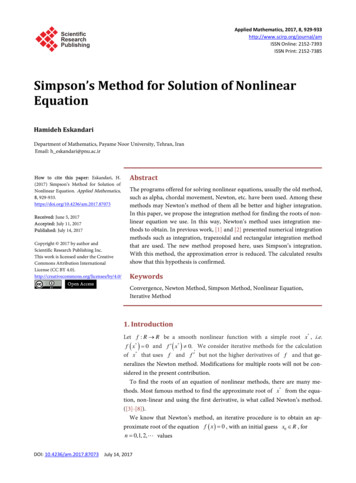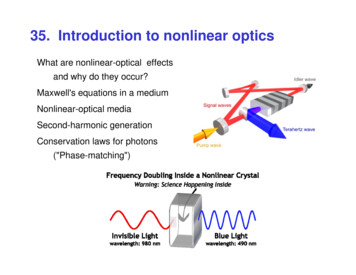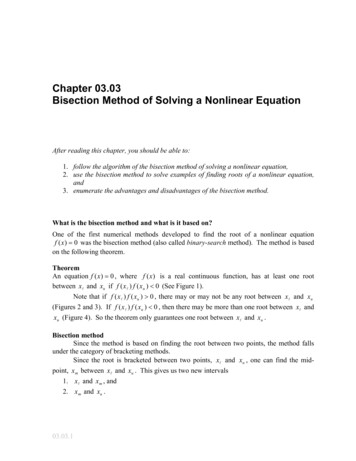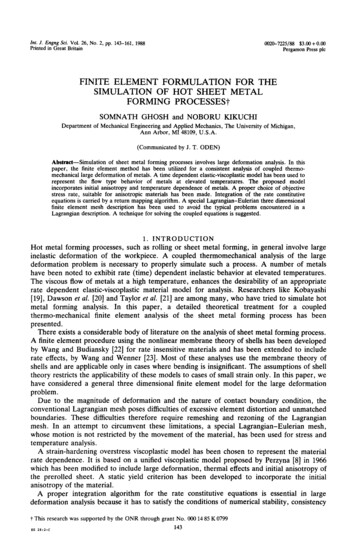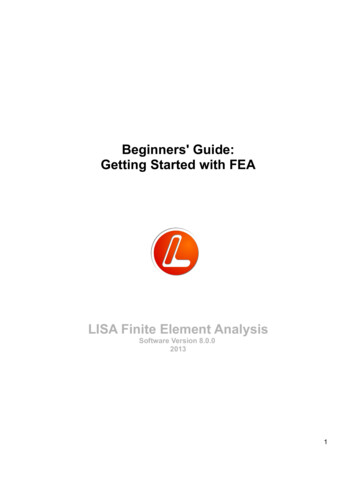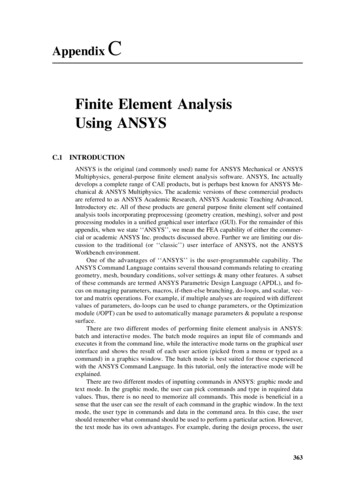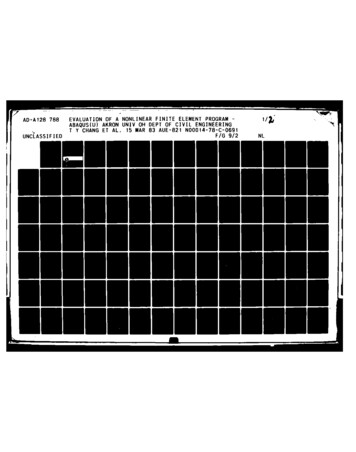
Transcription
7 AD-A128 788UNCLASSIFIEDPROGRAM2ELEMENTFINITEENGINEERINGOF CIVILAKRONUNIV OH DEPTABAQUS(U)OF A NONLINEAREVALUATIONAL. 15MAR 83 AVE-821 NOV 4-78-C 0691CHANGETF/G9/2
L9Uj 1225MICROCOPY' RESOLUION TESTCHART963-ANATIONAL BUREAU OF STANDARDS-1
Report No. AUE-821EVALUATION OF A NONLINEARFINITE ELEMENT PROGRAM - ABAQUST. Y. ChangS. M. WangDepartment of Civil EngineeringThe University of AkronAkron, Ohio 44325August 1, 1982(Revised on March 15, 1983)Prepared forOffice of Naval Research-ET--"2)UN 1Department of the Navy1983Contract N&)14-78-C-0691A187Th-Sb ijd-nment has been Qckp"ovo.xolsae and sale; its83 06 019%&1%0As'038j
Report No. AUE-821tEVALUATION OF A NONLINEARFINITE ELEMENT PROGRAM - ABAQUST. Y. ChangS. M. WangDepartment of Civil EngineeringThe University of AkronAkron, Ohio 44325August 1, 1982(Revised on March 15, 1983)""Prepared forOffice of Naval ResearchDepartment of the NavyContract NC14-78-C-0691*18b6.
TABLE OF CONTENTS. 1-11.INTRODUCTION . . .2.DOCUMENTATION. . . 2-1. 2-13.2.1User's Manual. . .2.2Theoretical Manual. . . 2-22.3System Manual. . .2-22.4Example Problem Manual . .2-3.PROGRAM ORGANIZATION AND DATA BASE DESIGN.PRE Program. . .3.2 MAIN Program . .3.13.2.1Input Step . . .3.2.2Procedure Library . . .4.3-1.3-4.3-5.3-73.2.3 Material Library. . . . 3-103.2.4.Element Library . .Data Base Design. . .4.1 Analysis Procedures . . .4.1.1Static Stress Analysis . . .4.1.2Dynamic Analysis. . . .4.1.3Heat Transfer Analysis . . .Element Library. . .3-13. 3-14.FUNCTIONAL. DESCRIPTION . . .4.2.3.2.5 Arithmetic Library. . . .3.33-1. 3-17.4-14-1. 4-1. 4-4. 4-8.4.2.1Truss Elements. . . .4.2.22/D Solid Elements. . . .4-84-94-9
ii5.4.2.3. .4-93/D Solid Elements .4.2.4Beams .4.2.5Shell Elements . . 4-134.2.6Elbow Elements . . 4-144.2.7Heat Transfer Elements .4-12.4-154.3Material Library .4-154.4Mesh Generation .4-174.5Kinematic Conditions . 4-184.5.1Equation .4-184.5.2Friction .4-184.5.3Gap .4.5.4MPC - Multi Point Constraints .4-19.4-204.6User Subroitines .4-204.7Input and Output .4-21VERIFICATION PROBLEMS .5-15-25.1Elastic-Plastic Deformation of a Cantilever Beam5.2A Cantilever Beam Subjected to an End Moment . . 5-45.3Static Analysis of A Pipe Contact Problem .5.4An Elastic-Plastic Spherical Cap .5.5Elastic-Plastic Deformation of A Plate .5.6A Circular Plate With Plasticity .5.7Large Deformation of a Cylindrical Shell . 5-235.8Post-Buckling of a Cylindrical Shell Subjected to aPoint Load .5.9.5-7. . 5-11. . 5-15. . 5-21Dynamic Response of a Cantilever Beam .5-265-26
6.ADVANCED EVALUATION . . .6.1An Elastica. . .6-1.6-16.2 An Elastic-Plastic Plate Subjected to Biaxial Loading . .6-56.3 A Cantilever Beam Subjected to An End Force . . .6-106.4Large Deformation of A Spherical Cap . . .6-196.5Buckling of A Spherical Shell . . . .6-216.6A Centrally Cracked Plate. . . .6-246.7Dynamic Response of A Spherical Cap. . . .6-396.8Dynamic Analysis of A Semi-Spherical Shell. . . .6-566.9Longitudinal Pulse in A Prismatic Bar. . . .6-60.6-67.7-16.10 Execution Time . . .7.SUMMARY AND CONCLUSION . . .8.REFERENCES. . .APPENDIX A. . .APPENDIX B. . .APPENDIX C. . .8-1.A-1.B-1.C-1.
ivACKNOWLEDGEMENTThis work is supported by the Office of Naval Research, Departmentof the Navy, under the Contract Number N00014-78-C-0691.Assistancereceived from the project manager, Dr. Nicholas Perrone of ONR, isalso appreciated.The authors wish to acknowledge Mr. E. J. Ni, a graduate studentin the Department of Civil Engineering, for helping a portion ofthis study.
31-11.INTRODUCTIONIn recent years there has been an increasing interest in finite elementsoftware evaluations due to the widespread availability of such packages.Also recognizing this need, an ISEG (Interagency Software Evaluation Group)associated with the armed forces and other government organizations-such asthe National Science Foundation, the Department of Energy, and the NuclearRegulatory Commission - was formed for continuous coordination of evaluatingengineering application software.In this connection, a set of criteria forselecting software, selecting contractors and evaluation procedures weredeveloped by Nickell [1,2].Subsequently, three general purpose finiteelement programs for structural mechanics applications were selected andevaluated.These are ADINA, NASTRAN and STAGSC-1 and the evaluation resultswere reported in references [3,4,5].A comprehensive summary of evaluationwork is given by Nickell [2].As a part of ISEG's continuing effort, ABAQUS was also included forevaluation.ABAQUS is a general purpose finite element code for nonlinearstatic and dynamic analysis of structural problems, as well as steady-stateand transient analysis of heat transfer proble:ns.The code was a relativelynew entry to the nonlinear structural software market; it was developed andreleased by Hibbitt & Karlsson, Inc., 1979.Although the version 3- ABAQUS*hds limited analysis capabilities (as compared to MARC [6] for example), itrhas the potential to become a major nonlinear code due to its modern conceptsoftware design and strong commitment in coding development by the company.*It is noted that only the version 3 of ABAQUS was available for theevaluation work. Therefore, whenever ABAQUS is mentioned again in thisreport, it implies the version 3 of ABAQUS.
1-2By following the procedure outlined in [1], the evaluation work consistsof the following:i)Review of documentationii) Program organization and data base designiii)Functional descriptioniv) Benchmark runs for coding verificationv)Benchmark runs to determine the numerical characteristics of ABAQUS(advanced evaluation).Since ABAQUS 4- marketed as a production code, unlike ADINA primarily as aresearch code, no attempt was made in the review of detailed programarchitecture.Instead, discussion is focused on the overall coding structureand its data base design.ADINA [3].This is in contrast to our previous review work onTne purpose of functional description is to give a comprehensiveoverview of the solution methodologies adopted and analysis features availablein ABAQUS.The section on verification problems is to demonstrate theoperational status of double precision version of ABAQUS on the IBM mainframe.Finally, a yreat deal of effort was devoted to advanced evaluation inwhich a selected number of benchmark problems were run to determine theoperating characteristics of ABAQUS in terms of its solution convergencebehavior and computational efficiency (i.e. CPU time).
2-12.DocumentationABAQUS is supported by four documents:*User's Manual [7]*Theoretical Manual [8] System Manual [9]"Example Problem Manual [10]2.1 User's ManualObviously, the purpose of user's manual is to provide specificinstructions on data input and to give a description of output features.Themajor importance of this manual is its clarity in instructions.The user's manual contains ten sections.Sections 1-4 are the referencesections in which input organization and syntax rules, analysis procedures,element and material libraries are described.input instructions.Sections 6-10 contain dataSection 5 is not included in the manual; it may have beenreserved to cover additional features which will be added into the program.For the most part, the manual was clearly written and easy to follow.Toprepare the input data for a problem, the user should be able to findsufficient information from the instruction sections.To input element andmaterial data, some cross-reference in Sections 3 and 4 is often necessary.Although the manual is generally well documented, two points may deserve somefuture attention:i)General shell section (6.5.9) is provided to allow direct input of ashell cross-section with elastic anisotropic, layered or corrugatedmaterial.However, the definition of section stiffness matrix D was notclearly specified.LConfusion exists in deciding whether the D-matrix
2-2-for large deformation analysis has the same meaning as the one for smalldeformation.An example is needed in order to clarify this point.ii) Restart (6.8.4) option can be exercised to save and reuse data andThe manual does not clearly illustrate how to useanalysis results.*RESTART option to conduct a multi-step analysis.For example, in thecase of dynamic analysis it is not clear that whether the analysis timeshould be accounted from the ve-y beginning of the analysis or from thestarting point of each new step?Similar question arises for thedefinition of new amplitude.2.2Theoretical ManualThe theoretical manual was written for the advanced user who has hadsufficient background in (nonlinear) continuum mechanics and wishes to knowThe man-jal include the following basic items:the theory behind the code." Review of basic mechanics principles" Description of analysis procedures" Element formulations* Constitutive theories* General formulations for heat transfer analysisAll basic assumptions are properly stated.are clearly defined.Kinematic and kinetic variablesThis is a very important point, especially for largedeformation analysis.In the element formulations, considerable details are given for the beam,shell and elbow elements.Discussion on solid elements is rather sketchy;related literature should be cited to compensate this effect.2.3System ManualThe system manual contains a fairly detailed description on the programdesign of ABAQUS.The purpose of this manual, as stated in [9], is intendedfor a user to have access to the source code.The user may be a system
Ii2-3prograiuuer who i s charged wi th i ristilYI'j',-program at a computer si te, or aperson who will make changes or additions to the code in order to solve atPparticular class of problems.The manual contains the following importantinformation:* Overall program design concept and decisionst0 Brief review of theoretical basis0 Detailed flow of the PRE and MAIN Programs0 Description of data base design and data base managers* Logic for allocation of workspace0 Description of labelled common blocks in PRE and MAIN0 Definitions of subroutines used6 User interfacesWhile the reviewer found that the system manual was helpful to undercertain part of the source code, a good portion of the manual has become outdated.A number of subroutines, which were added to or deleted from theprogram, are not mentioned.Therefore, the system manual,as the way itstands, can at most be used as a reference material until it is properlyupdated.2.4Example Problem ManualAn example problem manual which contains about sixteen sample problems isalso available.The purpose of this manual, as it appears, is to assist thenew user in setting up problems, or to verify the code upon installation.Each problem is presented in a standard format:problem statement;description of material, geometry, loading and boundary conditions; resultsand discussion; listing of input.clearly explained in the manual.In general, the example problems areHowever, most of the problems are
2-4concentrated on the use of beam or pipe elements with elastic orelasti-plastic materials.There is a lack of representation of differentelements or material models.Furthermore, the manual that the reviewer has isin a rough draft form which does not follow a proper sequence order.
3-13. PROGRAM ORGANIZATION AND DATA BASE DESIGNABAQUS was designed primarily as a production code for solvingnonlinear problems.The program must be run on a fairly big computer (such asa mainframe or a super-mini computer) so that a reasonably large core size canbe allocated in order to maintain its efficiency.In terms of its codingstructure, ABAQUS is divided distinctively into two sub-programs:and MAIN programs.The major functions of PRE are:namely PREi) to read the input dataand sort the data onto a data structure from which the MAIN will read, and ii)to perform data check analysis.On tne other hand, the function of the MAINprogram is strictly for engineering analysis.The obvious advantage of thisdivision is that the PRE can be repeatedly run alone for data checking withquick computer turn around time.This feature is extremely helpful forcomputer systems which assign higher priorities to jobs with short CPU timetand/or small central core usage.In addition, ABAQUS utilizes an extensive data base design concept inthe development of its coding.*advantages:This approach provides three apparenti) protection for data file over-write, ii) efficient utilizationof fast core storage, and iii) ease of future coding extension ormodifications.In this section, we will review each of the following threeitems in ABAQUS; i) PRE program, ii) MAIN program, and iii) data base design.3.1PRE ProgramThe major functions of the PRE, as stated in the AI3AQUS system manual[9], are to perform data check and create the data bases for the MAIN.Thedata bases are written onto a communication data base which are then passed onto the MAIN.If any fatal errors are detected, job execution will beterminated at the end of PRE.
3-2The PRE programi consists of 9-modules which are executed sequentially.These modules are differentiated by step designations:Step 1. Scan input data - The PRE reads all input data and provides an'echo' printout of user's input data.All the common blocks are initializedand the locations of the data bases are defined.Each data base has aconstant length of 1024 words except that the node point data base has alength of 2048 words (double precision for IBM computer).Also, the buffersof the data bases are initialized.Step 2. Read bulk data -The input data are read again and they are separatedinto two different types:a) Bulk data -data associated witn elements, nodes,element sets, and node sets, and b ) short list data -data other than a. Meshand incremental generations, if encountered, are performed.Information suchas BEAM SECTION, MATERIAL, STEP, etc. are written onto an input data base, andan input data manager is also created.The buffer space for the input database manager was set to 1500 words in the program; 3 -words required for eachinput keyword card.Therefore, a maximum of 500 keyword cards can be read infor the current version of ABAQUS (version 3) unless the buffer space isenlarged.The short list data is separated into different volumes.At theend of this .tep, volume 1 of short list data base is extracted from a datablock in subroutine BELTYP, and then copied onto the buffer area of the shortlist data ba-.e.Step 3. Read material properties -Material property data are read and writtenonto volume 1 of the short list data base.Volume 3 of short list data baseis also defined.Step 4. Build element data base - Element data base is created from elementdata and spe,:ial elements (springs, dashpots, etc) are inserted at appropriate
3-3points in the data base.All element information (shell sections, beamsections, distributed loads, etc.) are interpreted and resolved onto the9element data base and the short list data base (volume 4).Also, the nodesare assigned with internal numbers based on the element ordering.Step 5. B3uild node point data base-Node information, such as point loads,boundary conditions, transformations, etc., are interpreted and resolved ontothe node point data base and the short list data base (volume 5).Step 6. Build step- dependent part of Short list data basedependent part of the short list data base (volumes 6--the step-9) is created for eachanalysis step.Step 7. Space allocations for the MAIN -Based on the global sizing values forthe MAIN analysis program, space allocations for the MAIN are made.Theparameters for the array pointers (starting addresses of arrays) are stored incommuon blocks.The imaximum sizing is limited by a parameter MCOREM, which iscurrently set to be 4S,000 words.For problems exceeding this capacity, anew value may be assignedl to MCOREM in the main driver of PRE.Step 8. Plot undeformed mesh.Step 9. B uild communication data base-In order to pass all necessaryinformation (values of array pointers, control variables, etc.) from the PREonto the MAIN, a communication data base is created and copied on disk or tapeunit #23.It consists of common blocks, element data base, node point database, material point data base, and short list data base.Finally, a driver for the MAIN is written onto a disk or tape unit #28.typical drivers are shown as the following:Twoj
3-4For Stress Analysisa)DOUBLE PRECISION SINTCOMMON / CSP / SINT (45000)CALL EXEC*STOPEND*Executive module for stress analysisFor Heat Transfer Analysisb)DOUBLE PRECISIONCOMMON / CSP / SINT (45000)CALL HEXEC A*STOPEND* Executive module for heat transfer analysis.The driver is compiled into an object module and kept on a temporaryfile.After linking the driver to the object module of the MAIN, the analysisof MAIN Program starts.3.2MAIN Program.The MAIN contains a number of modules which perform the actualengineering analysis.In the current version of ABAQUS, there are three majoranalysis branches:Stress/strain analysisOffshore analysis*(not active in reviewer's version)Heat transfer analysisEigenvalue analysis
For a typical analysis branch, several modules are executed in a loopmany times over due to the incremnental (or time-history) solution approachThe main loop consists of three prime calculation stages:being used.material calculations,ii) element calculations, andi)iii) solution ofDetailed descriptions of the modules in the MAIN are givenmatrix equations.in ABAQLJS system manual [9].In this section, we shall review ABAQUS'organization by considering the following:Input Stepf* Procedure Library* Material LibraryElement Libraryf.** Equation Solver* Arithmetic Library3.2.1Input StepIn accordance with the type of analysis requested, an executivemanager is called to read the data on communication data base from disk #23sequentially.word length.The buffer size of communication data base was set to be 512 inAll data in the buffer area of communication data base are thencopied to appropriate common blocks and(dtabase is also defined as shown in Table 3.1.problem dependent.Tape unit for each dataThe core storage arrangement isFor a relatively small problem, the buffer area is dividedinto several segments and a work space.by a data base.bases.Each segment is occupied exclusively(On the other hand, for large problems several data bases mayshare a common segment in the buffer.division are saved in common blocks.All the pointers for the bufferFor example, in the material generation
3-6Table 3.1TapeNumberTape Arrangement in the MAIN ProgramSequential!RandomDescription1SEigenvalue data base / half-step residual file2SDecomposed equation file3SElement nickname data base / Quasi Newton data base*4STemporary file for node point data base5SRead input6SWrite input8SFILE output data base12SRestart data base19SElement operator data base*20SElement operator data base215Material point data base22SMaterial point data base23SCommunication data base24SMaterial stiffness data base /temporary elementOutput file / solution nickname data base/postplot file25SElement data base*26SElement data base27RShort list data base28SElement nickname data base / Quasi-Newton data base*29RNode point data base305Element mass matrix data base*One for read-onefor write*
3-.7module pointers are stored in the commwon block called "CMATGI",element generation module pointers are in "CELGI'.whereas in theMost of the array pointersare defined in the PRE program although some of the pointers are calculated inthe MAIN whenever they are needed.can be made:In view of this, two immediate coimmentsi) If any array allocations are to be redefined in the MAIN,related changes on the definitions of the pointers must also be made in thePRE program, and ii) changes become difficult if the data structure of thedata bases is involved.t3.2.2Procedure LibraryCurrently, there are four executive managers which control the procedureoptions, namely"Static Analysis (EXECS)*Dynamic Analysis (EXECD)"Natural Frequency Calculations"Heat Transfer Analysis (HEXEC)(EXECEV)The relationship of the procedure library for stress analysis, with the inputmodule in the MAIN is shown in Fig. 3.1.manager is almost the same.Macro flow for each executiveTypical steps for static stress analysis areoutlined as the following (Fig. 3.2):i)ii)Initialize step and set-up increment information.Calculate material stiffness D (i.e. stress-strain relations)for each material point.iii)iv)v)Calculate element stiffnessSolve the system of equations by the frontal methodUpdate the material stiffness for the case of nonlinearmaterials
3-8Initialization of Control Variables & Arrays(FIXVAL)Read Records from Communication Data Base(INPUT)ProcedureLibrarySolutionAnalysisFig. 3.1.ctdautiAnalysisoAnalysisModules of Procedure Library
3-9tiSet up S EL GEN)Solve SystemEquations byFrontal Method,Sol ve)Update Node Point DataBase (eu), CalculateStrain, Write It tomaterial DB.IUpdate Material ergencenFig. 3.2esnoNext increment)ReturnMacro Flow of Static Stress Analysis
3-10vi)Calculate stresses and residual forces at integration pointsvii)If the solution has converged, update the nodal point databaseviii)Print output for element and nodal informationix)3.2.3Proceed the analysis for the next time increment.Material LibraryThe library is controlled by the module driver called MATGEN.Thepointers for defining the workspace are stored in the common block 'CMATGI'.The material stiffness data base pointers and other related information to thedata bases are initialized in the subroutine MINIT.For every material point(which may differ from the element integration point), material type ischecked and the corresponding control variables are defined.Six differenttypes of material models (or routines) can be called to generate the materialstiffness matrix D: MATELA - Linearly elastic materials with isotropic, orthotropic andanisotropic properties.*MATEXP - Linearly elastic thermal expansions with isotropic,orthotropic and anisotropic properties.*MATELG - Linearly elastic materials for general sections (optionsavailable for beam and shell elements). MATEXG - Linearly elastic thermal expansions for general sections.*MATCRP-Creep models (strain-hardening, time-hardening or user inputcreep law) and irradiation induced swelling.*MATPLA - Plasticity model (von Mises plasticity with isotropic orkinematic hardening law).The effects or rate- andtemperature-dependence core also available.
3-11Also, other material options, such as density, conductivity, specific heat,etc. for heat transfer analysis, are defined in module HEXEC.Two stages of calculations are involved for material generation:a) Material stiffness calculations,andb) Material data updating.For thematerial stiffness calculations, the following steps are executed for allmaterial points:i) Set up material dataii) Calculate the thermal strain, if it is required.iii) Calculate initial strain for creep and swelling, wheneverappropri ateiv) Compute tangent modulus.v) Write the data on the material stiffness data base.For the updating stage, executions include:i) Compute stress increments.ii) Insert new state on material point data base record.iii) Write the data on the material point data base.A flow Chart for the material calculations is shown in Fig. 3.3.Both thematerial stiffness and material point data bases provide necessarycommunication inforinal-ion between the material library (module MATGEN) and theelement library (module ELGEN).It is seen that in ABAQUS the materiallibrary is completely independent, in terms of coding organization, from theelement library.element types.That is, the material models are uniformly available to allThis feature is different from ADINA [11] in which thematerial library is a sub-module of each element type [2].
3-12OBMK: Ra MaterialifesDt aeInformationSLUPeSi aEeintFig. 3.3Flo Car.foMteilLGneaton
3-133.2.4Element LibraryThis library is commanded by the routine ELGEN (module driver).Itsprimary purpose is to calculate element stiffness and other element data andthen update the record on the element stiffness data base.made in a loop for all elements.Calculations areThe major calculation steps involve thefollowing:i) Call ELSET to read element informationii) Read data for all material points of the element from materialstiffness data base to workspace.iii)Initialize element stiffness matrix [K] and element residual vector[Re}-iv) Form element strain-nodal displacement transformation matrix [B].v) For dynamic analysis:a. Calculate th e mass matrix [M] for the first time incrementb. Add the effect of initial conditions to the right hand side forcevector [Re".c. Form effective stiffness matrix [S].Vi)Check tVie value of control variable NREF for appropriate adjustmentof stiffness matrix [K] or [S], and force vector {Rela. Additional terms due to distributed loads or foundation stiffness.b. Coordinate transformation from local to gobal system.c. The effect of boundary condition.d. Equations for multi-point constraints.
3-14vii) For the first iteration of an increment, write (Re} to node pointdata base.Otherwise, read {Re} from node point data base.viii) Write element stiffness data base record consisting of [S] and [R].3.2.5Arithmetic LibraryThis library consists of several utility packages which are accessible toall the modules in ABAQUS.These packages are:*Matrix addition*Matrix subtraction Matrix multiplication*Element stiffness calculation; f [B]T[D] [B].V Calculation of element residual force vector,{Re} {Re}-f [B]T{a} dvV*Copy a double-precisioned real array to an integer array.*Copy an integer array to a double-precisioned real array.*Cholesky decomposition of a matrix.*Q-R algorithm Vector normalization, etc.Obviously, by consolidating all the utility subroutines in a library, ABAQUShas avoided any repetitive coding as it was commonly done in other programs.Finally, to show the inter-relationship of various modules in the MAINprogram, a chart is drawn in Fig. 3.4.The hierarchical level of the modulesis that any module can only call other modules inside of its circle.One may
3-15Static AnalysisDynamic AnalysisHeat baseMaterialpointdata terialElemeniShortlistdatabasebaseStatic AnalysisElementQuasi-Materialstiffnessdata baseNewtonElementmassdata baseArithmeticLibrary2/D SolidsRestartdata base40NicknameoatabaseStaticdata ibraryDynamicAnalysisNotaCtivelig. taShelfDynamiccationdataOutputLibra,, yQuasi-NewtonetRelationsiiips 6e-Lween Various ModuIcsin the Main Program.Analysis
3-16note that the interaction between the element library and the material libraryis made through material stiffness and material point data bases.Commentary:1) Separation of the entire program into PRE and MAIN provides apparentadvantages:a) Short turn-around time - Running the PRE program only takes a fewseconds or a few minutes of CPU time, which has high priority inexecution.b) Smaller core requirement-In PRE, all real variables are in singleprecision and it requires no more than 750 K bytes core size toanalyze a fairly sizable finite element problem.The PRE can be run either separately or consecutivelywith the MAIN.2) The code was very modtlarly constructed for ease of extension ormodification by the developers.3) The codings of ABAQUS are generally difficult to follow by a non-developersince there are very few comment cards in the program for explanation.4) The material library is an independent module from the element library.Therefore any existing material models in ABAQUS are uniformly availableto all element types.5) Although ABAQUS was modularly constructed, to add a new material model orelement type into the program by a user is by no means obvious.Not onlyone has to add subroutines corresponding to the new material model or newelement, but also changes have to be made in the root subroutines of themain.Moreover, a number of subroutines in the PRE must be modified.
3-173.3Data Base DesignABAQUS utilizes the data base concept in both PRE and MAIN programs.Inthis concept, the data are separated into several files, each file is handledindependently.In the program a master array called INTS is allocated and itis divided into data base page pools (or buffer areas) and working-space.data files are stored in the page pools with pre-assigned sizes.decision is made in the PRE program.The sizingFor example, the data base structureused in the PRE is shown in Fig. 3.5.The lengths of the page pools will notremain fixed, they can be redefined during the analysis.allocated in the fast core area.AllAll page pools areIf, for a particular data file, the pagepool is not large enough, sec
ABAQUS is a general purpose finite element code for nonlinear static and dynamic analysis of structural problems, as well as steady-state . Obviously, the purpose of user's manual is to provide specific instructions on dat
